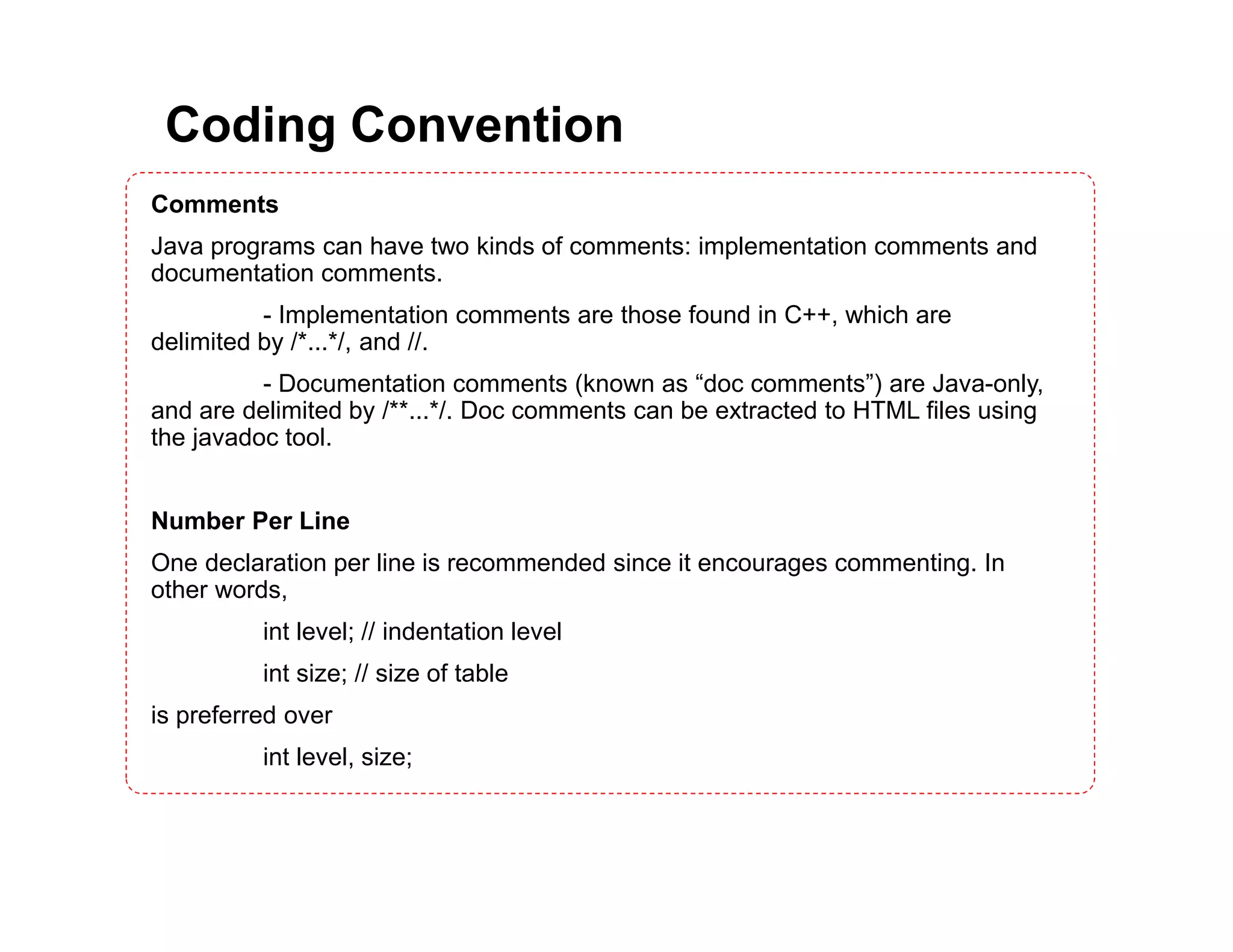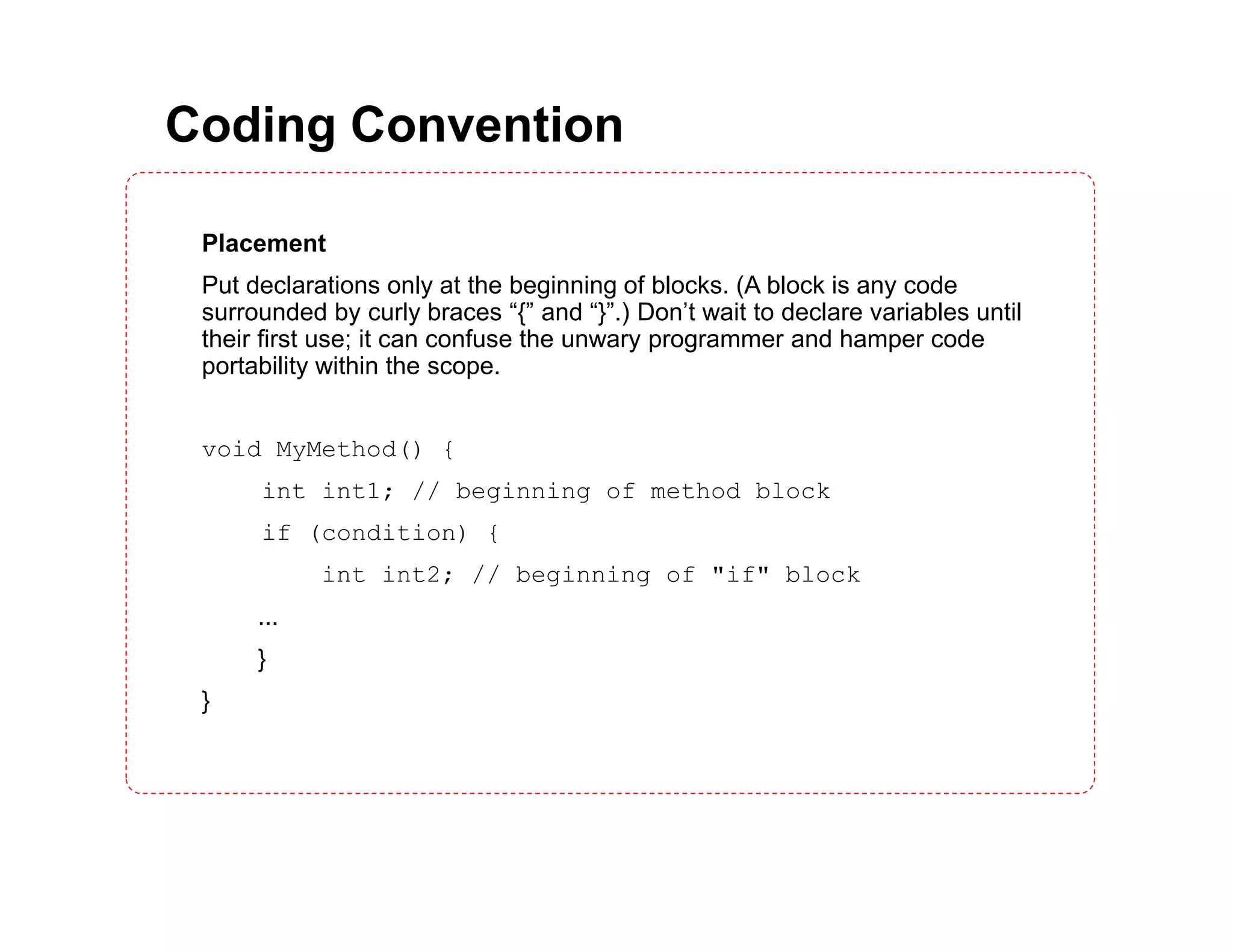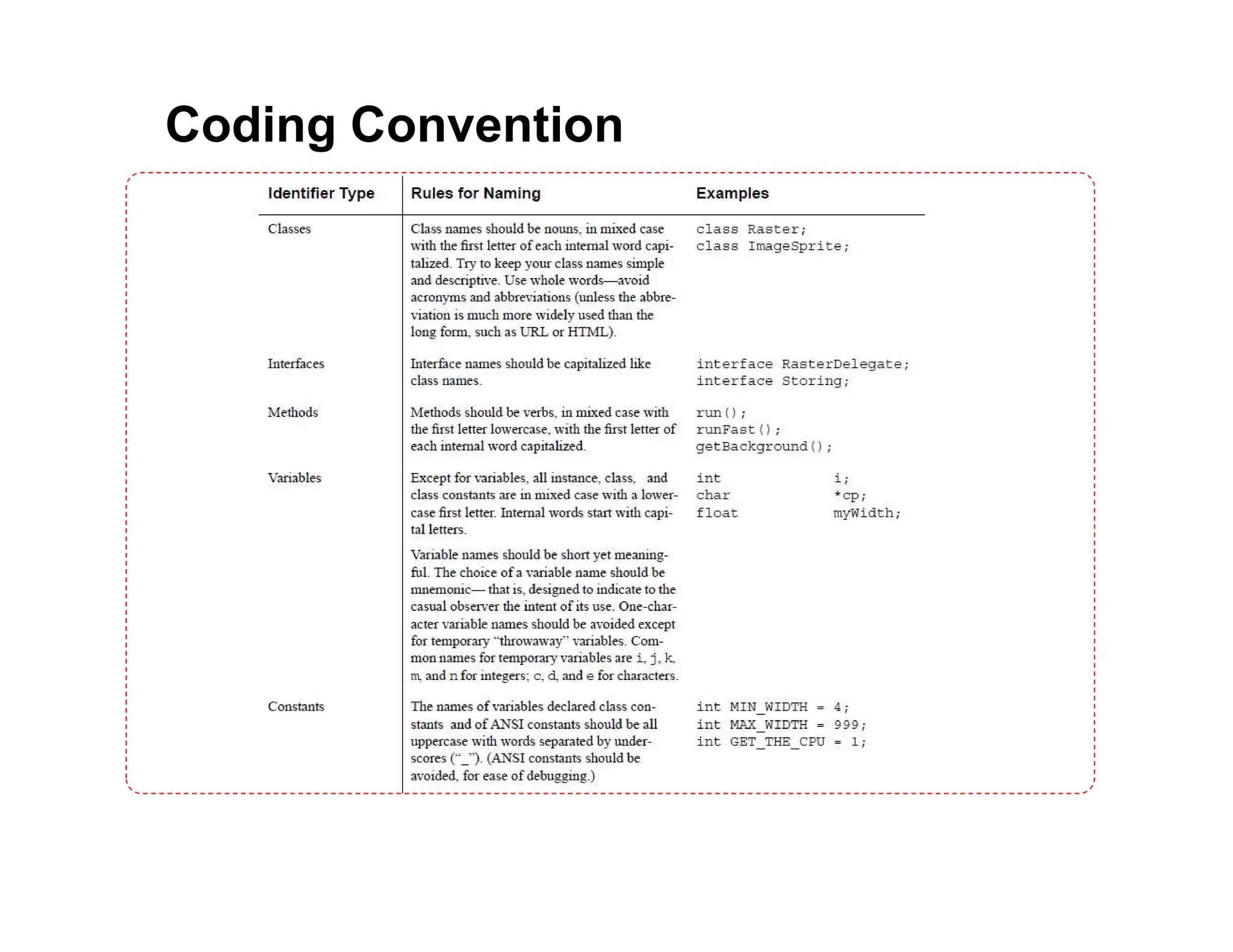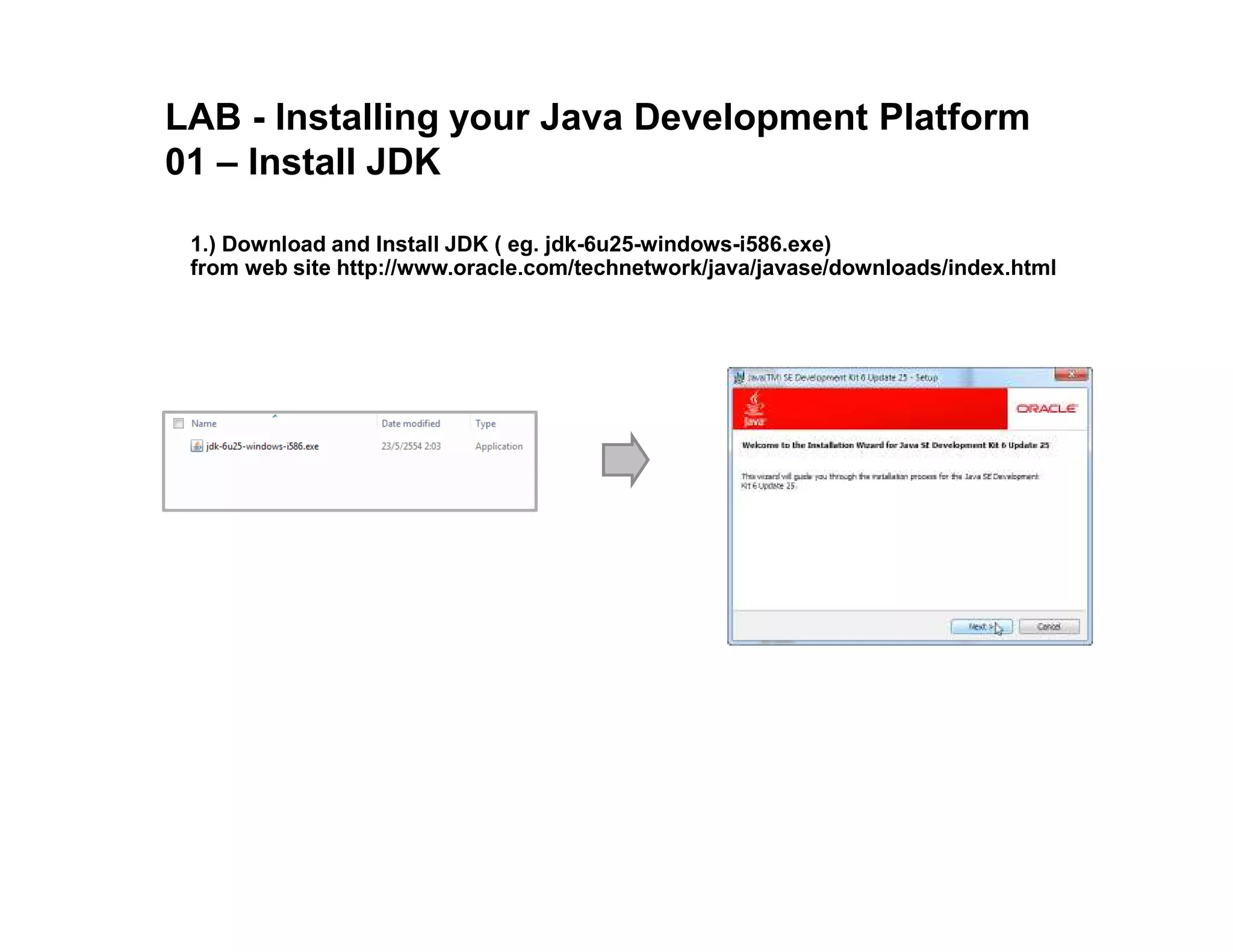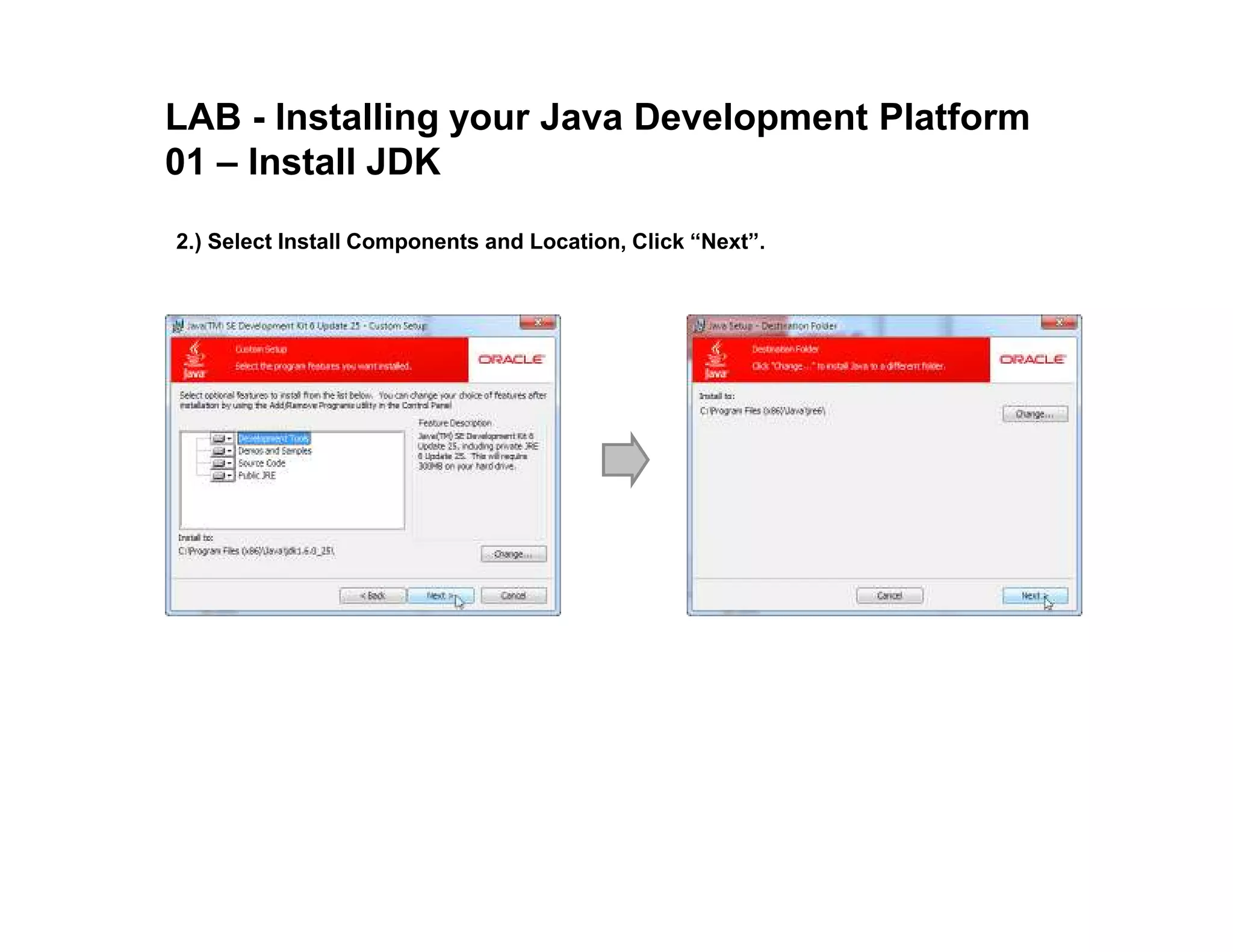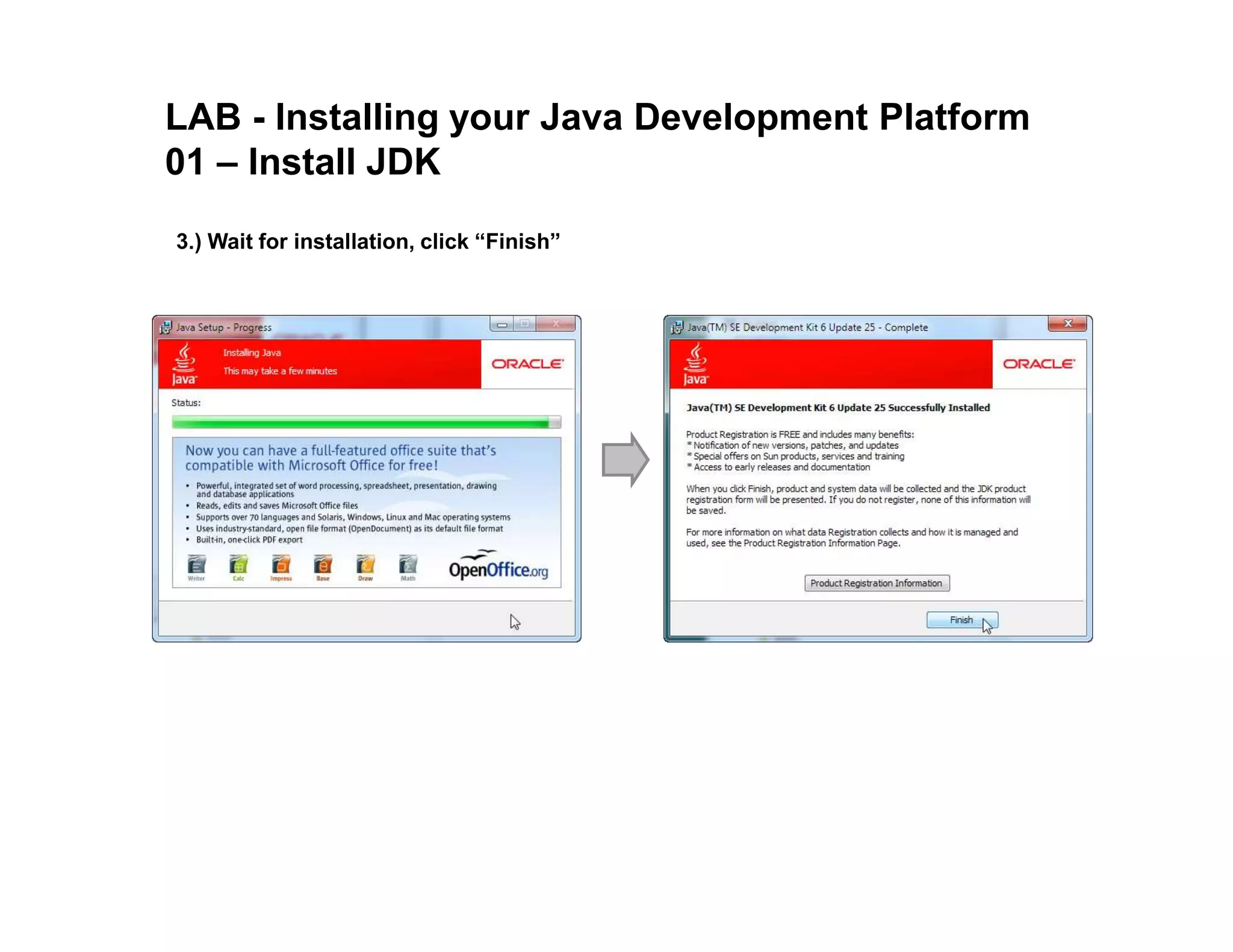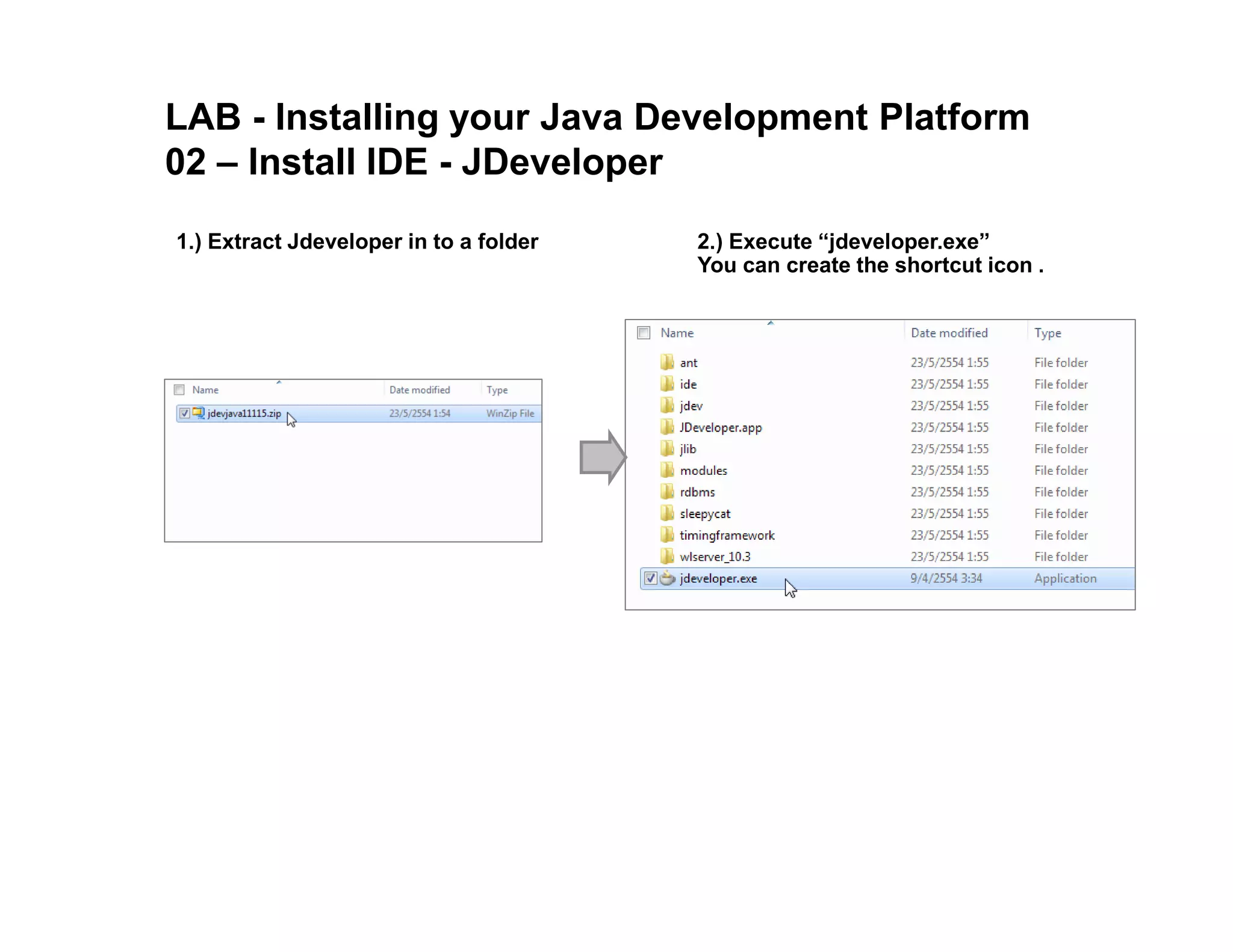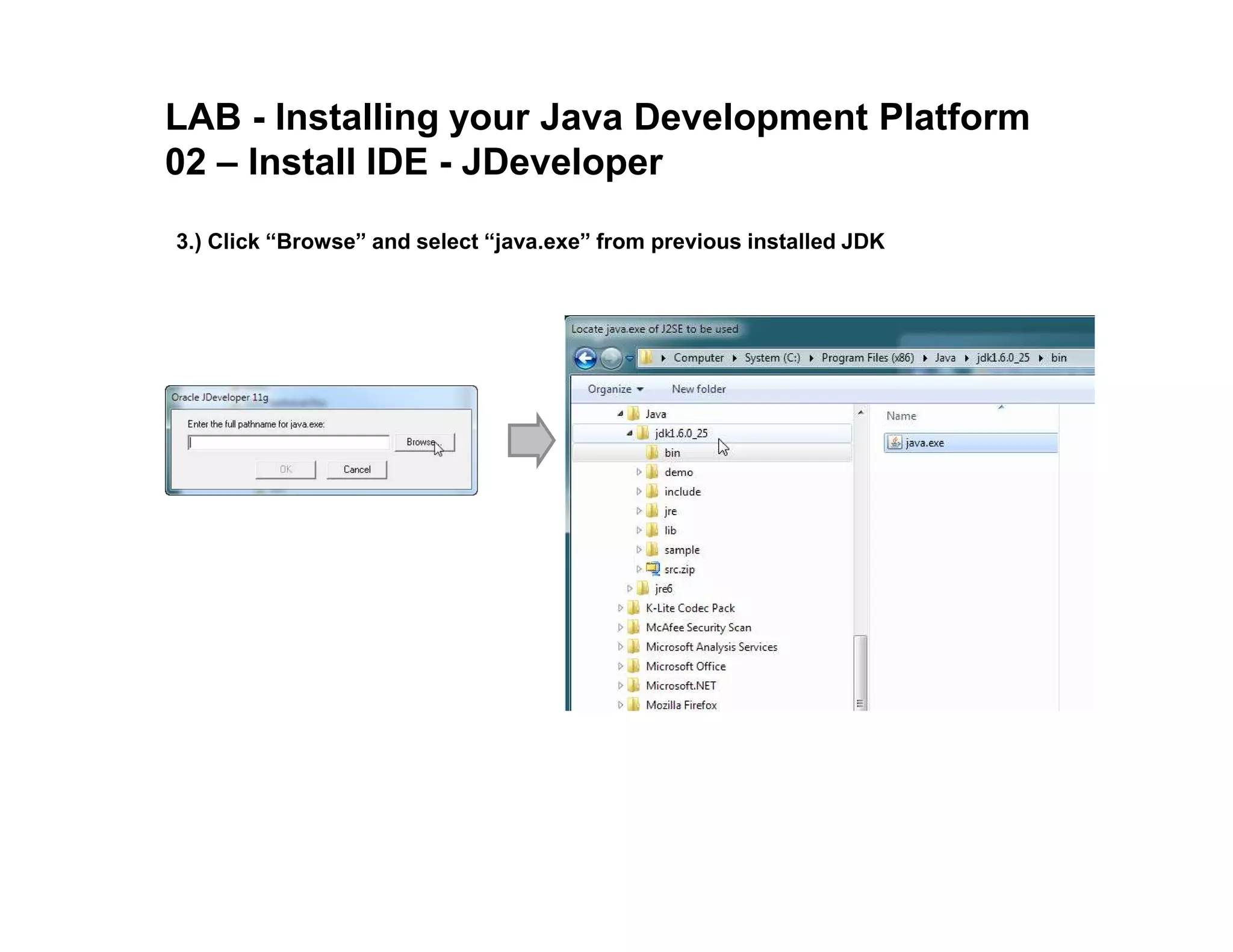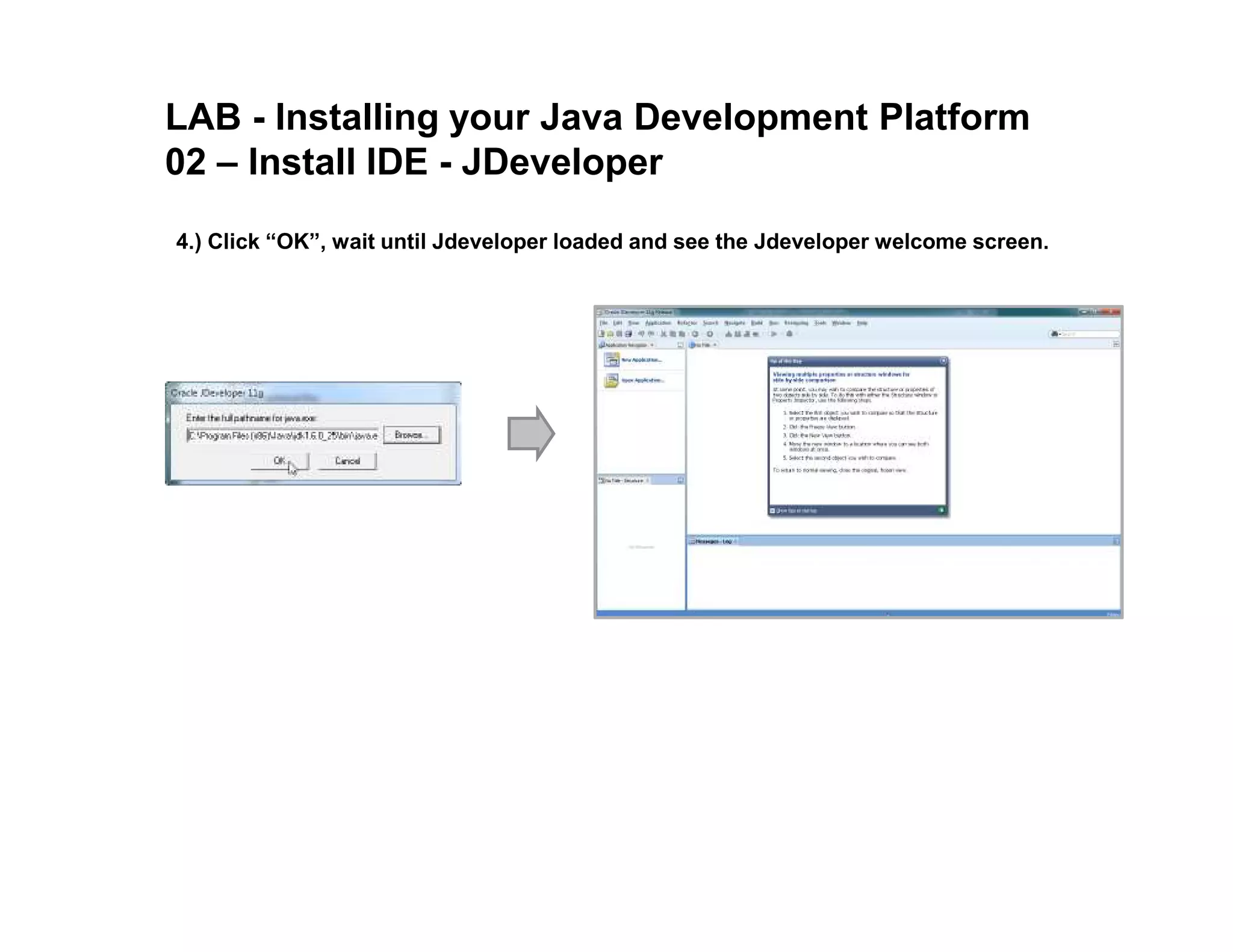This document provides an outline for a course on fundamental Java programming. The outline includes 8 modules that cover topics like introduction to Java, basic programming, object-oriented programming, file input/output, networking, and threading. The document also provides background information on Java history, principles, platforms, and the HotSpot Java Virtual Machine. It discusses Java's development from 1995 to present and goals of being simple, secure, portable, high-performance and dynamic.
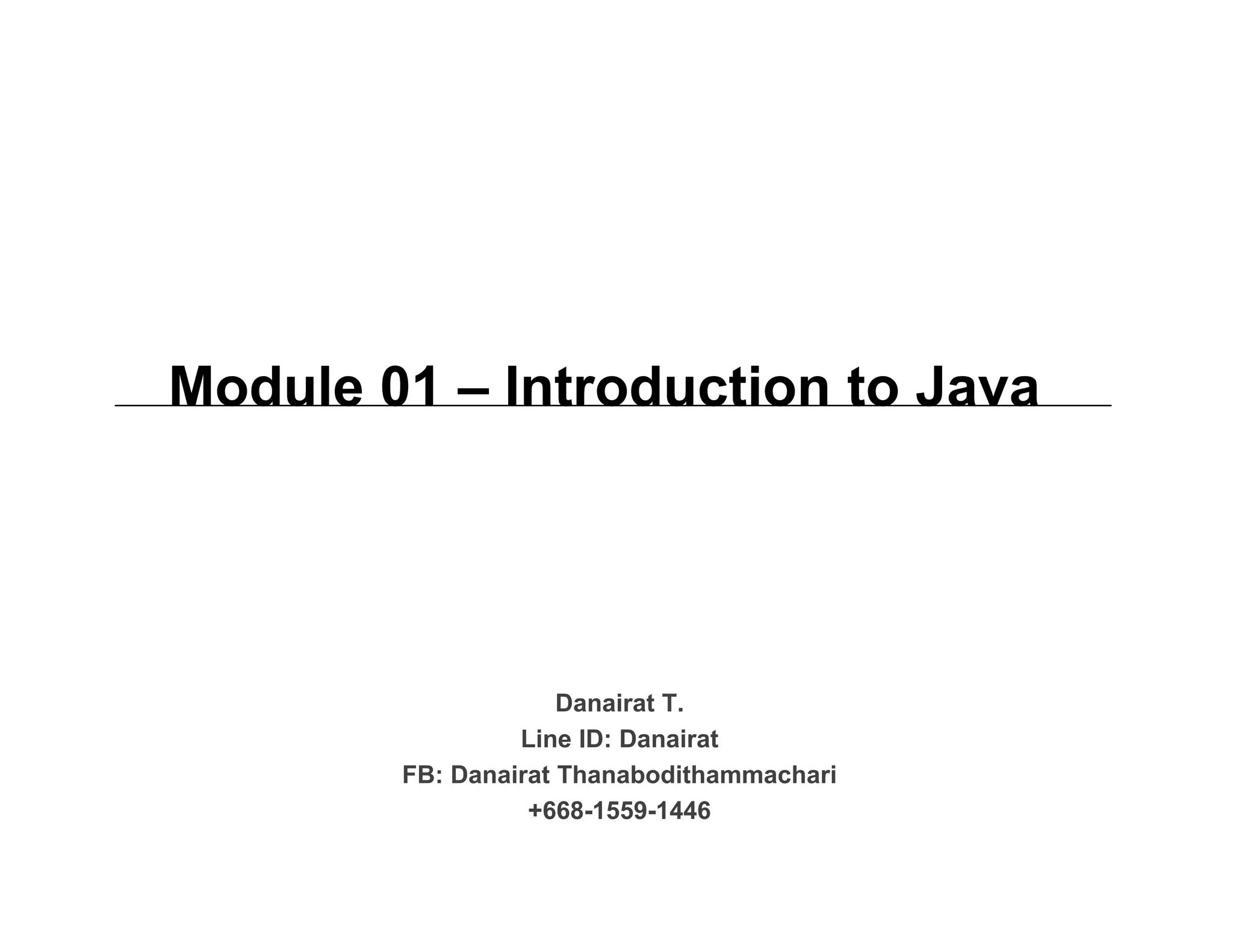


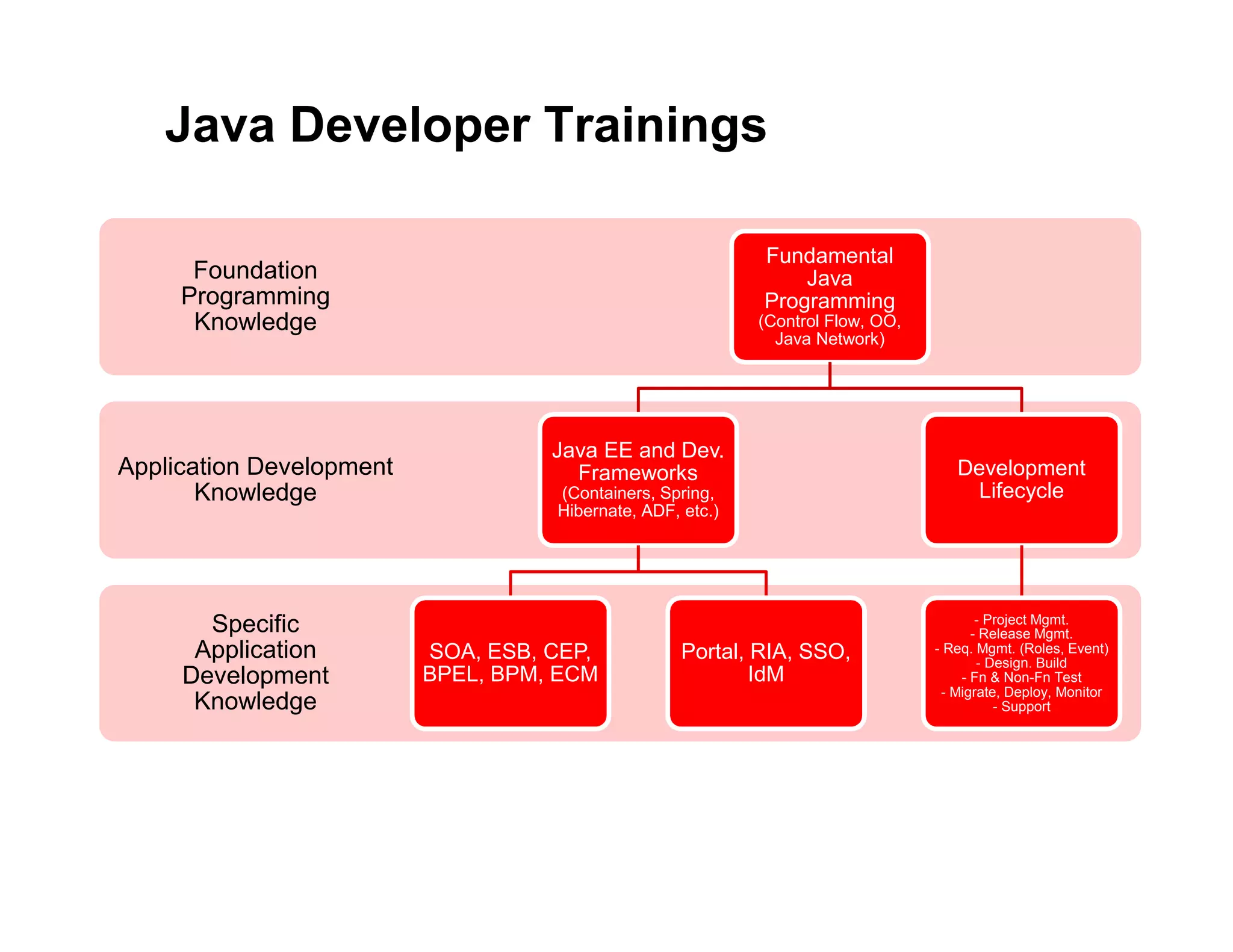
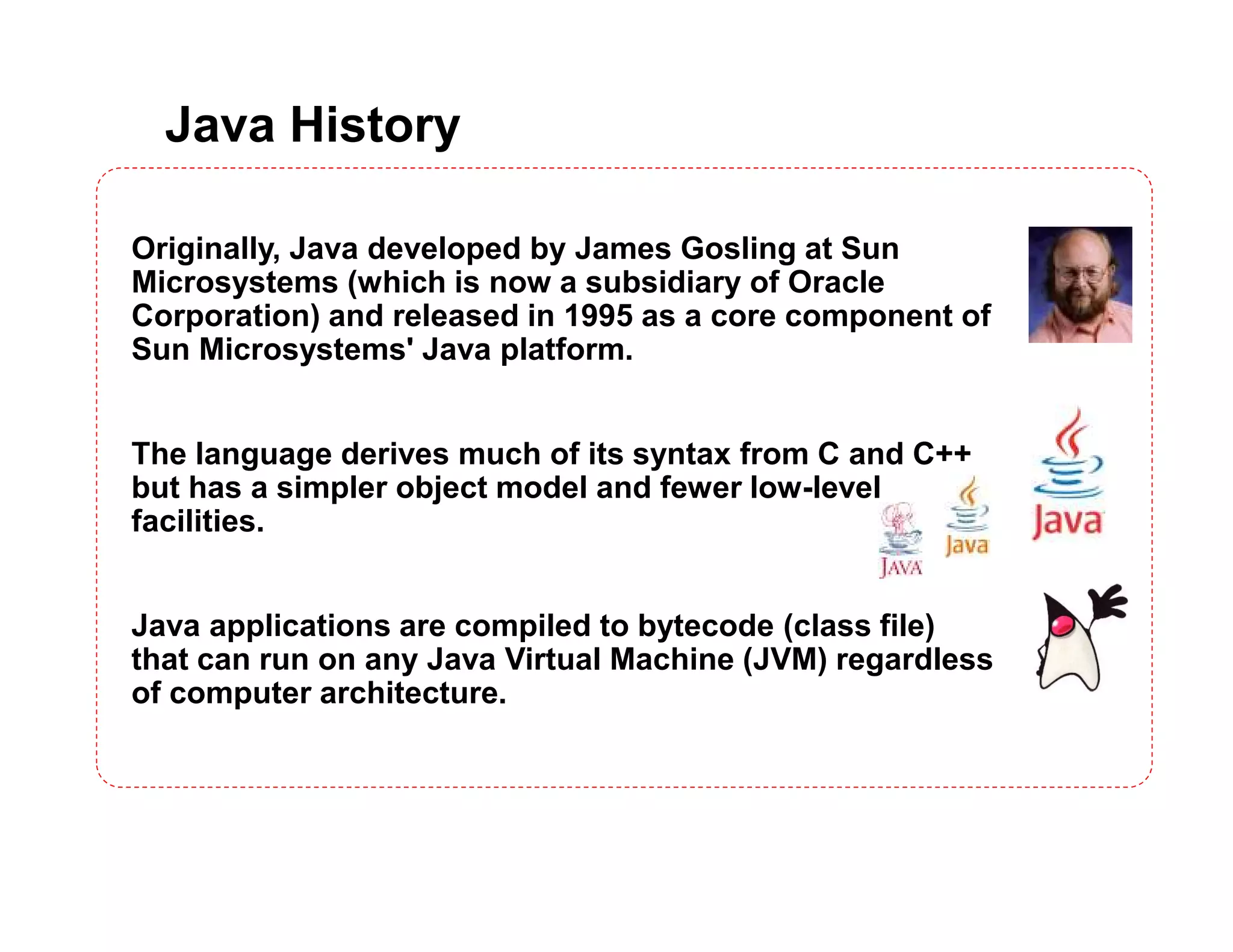

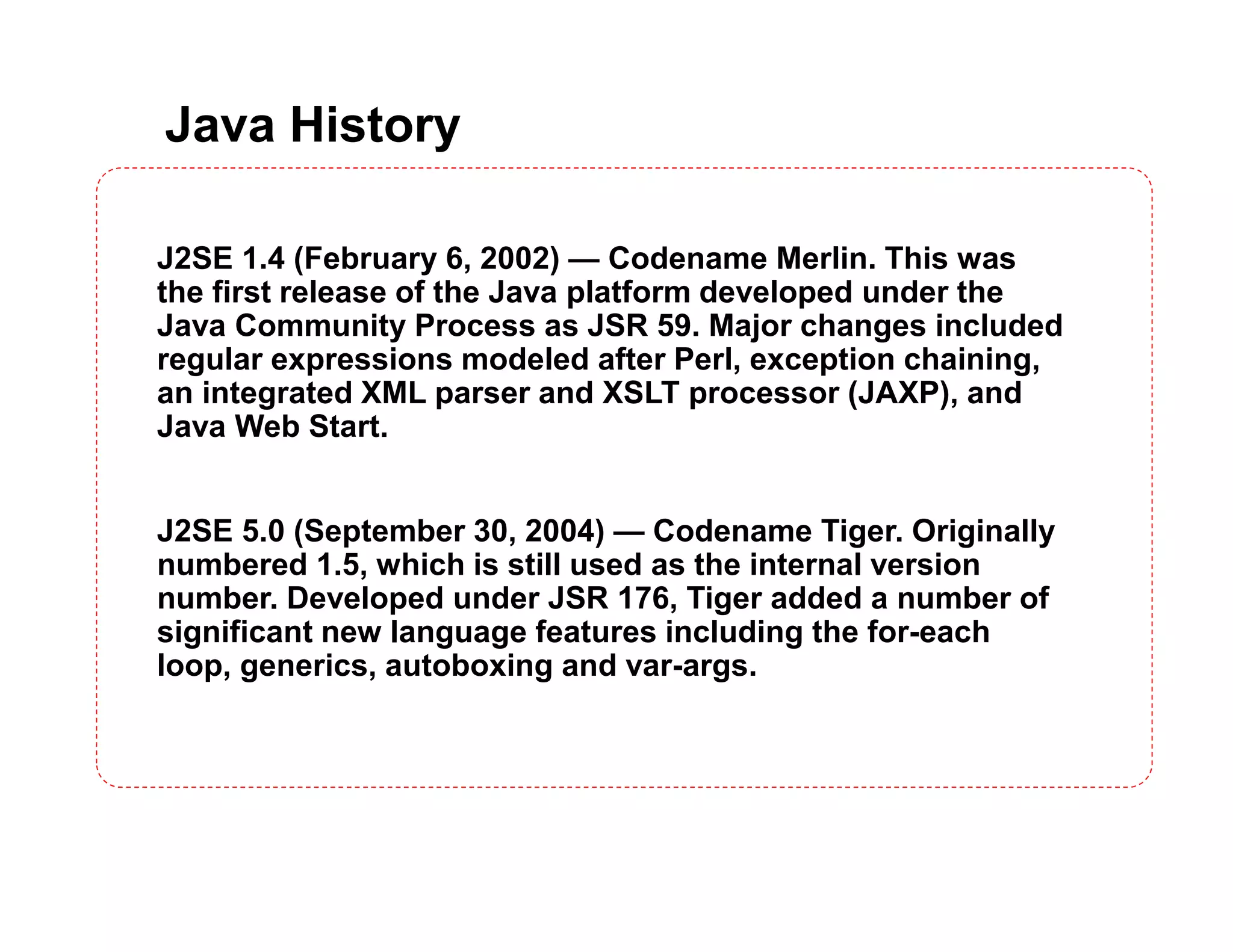
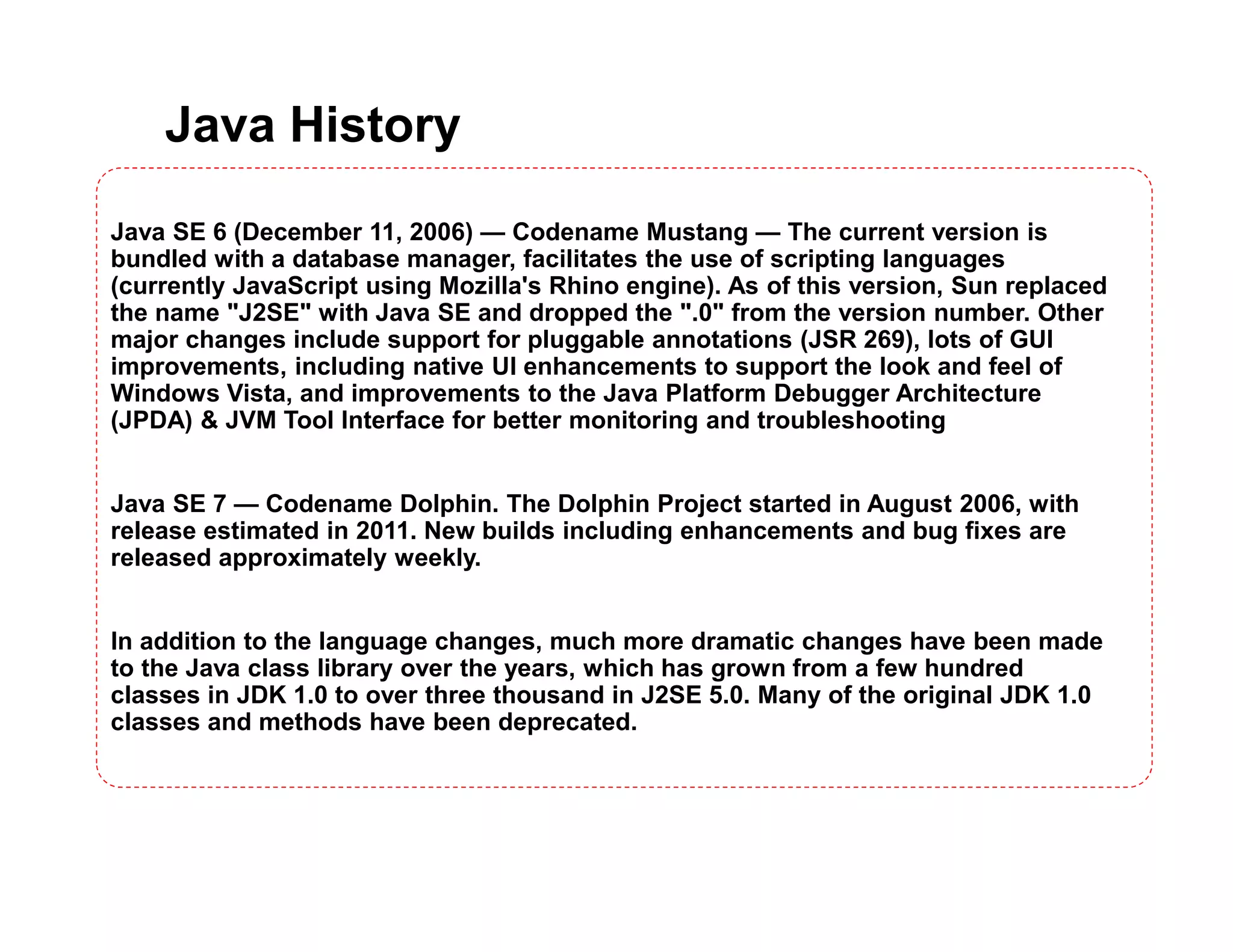
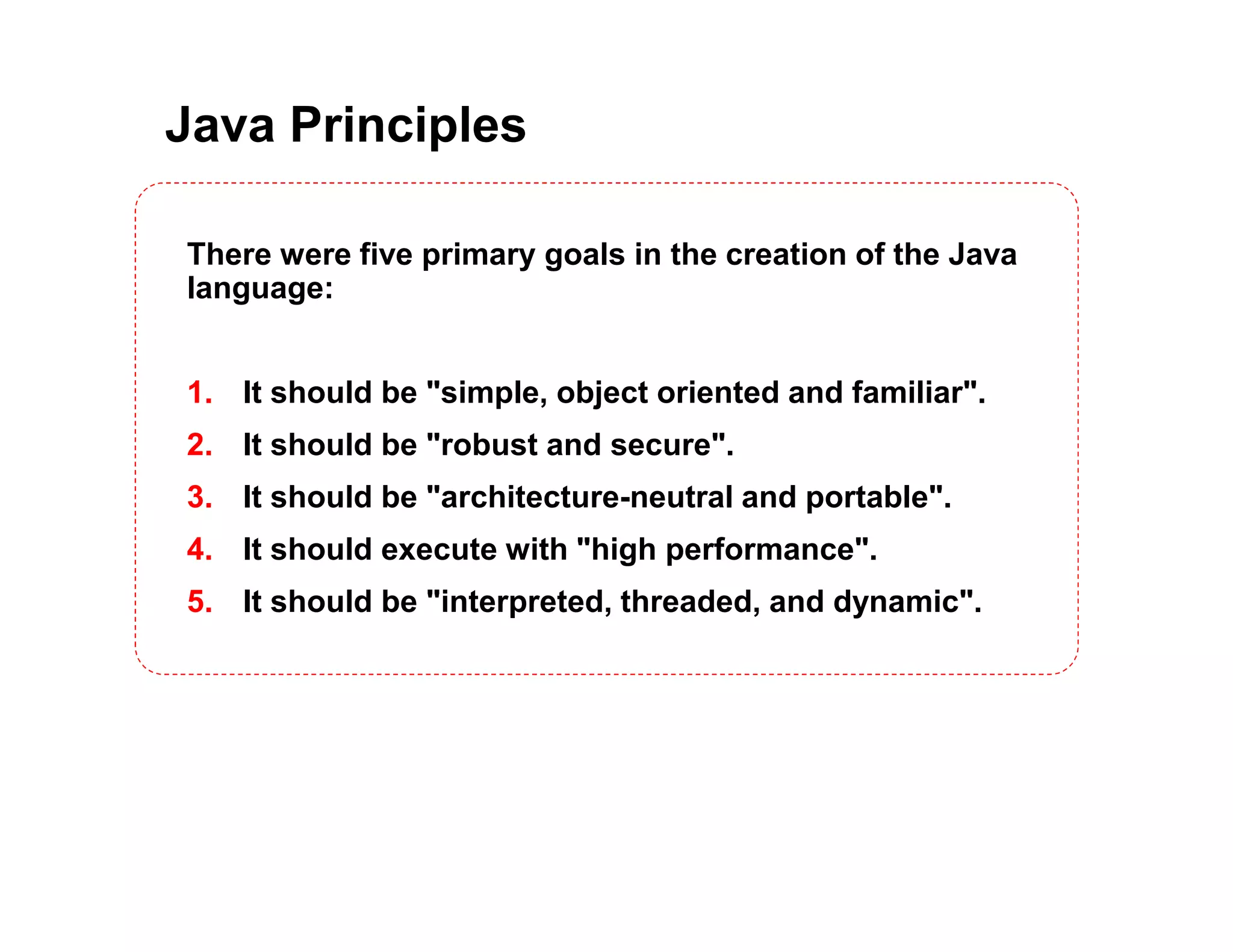
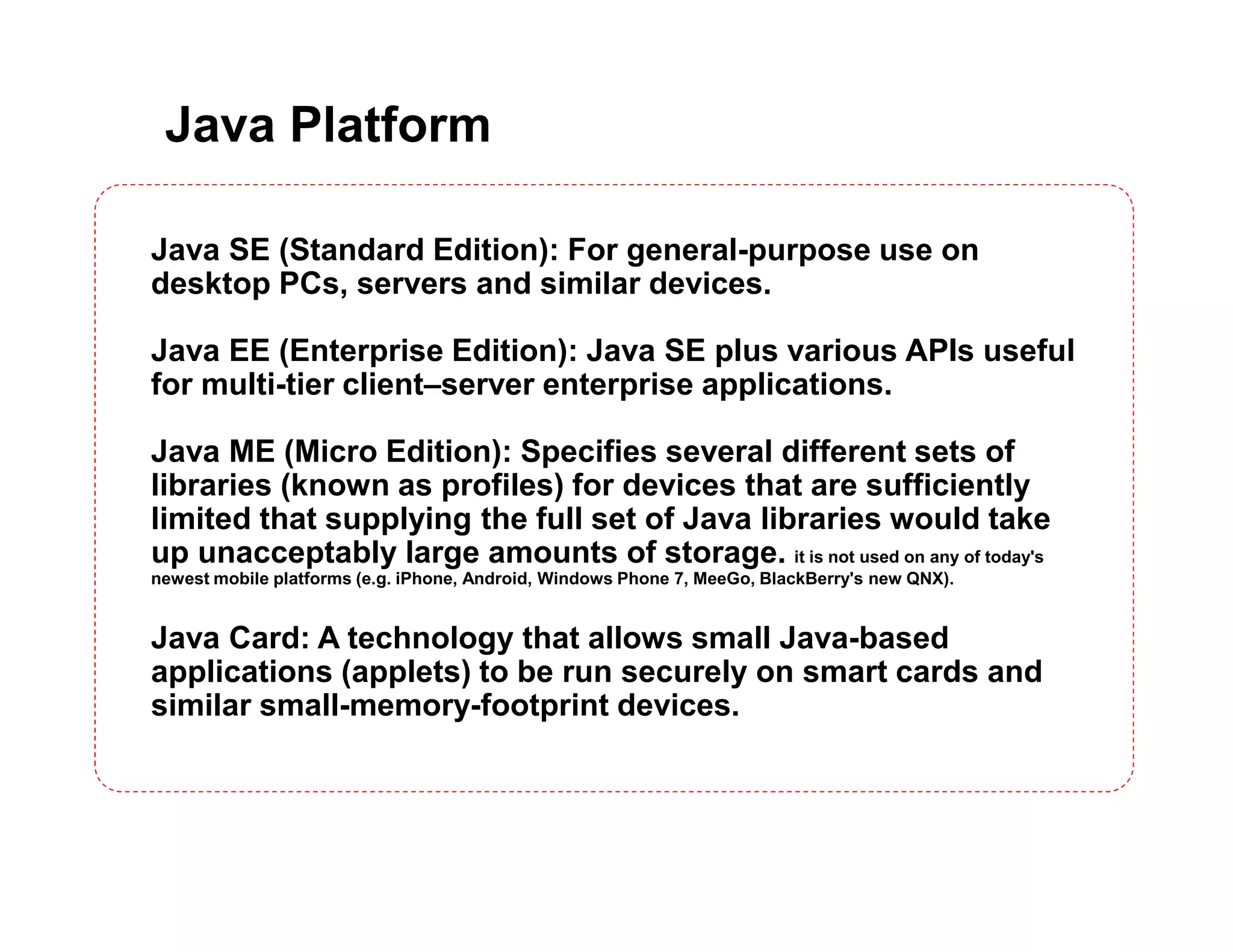
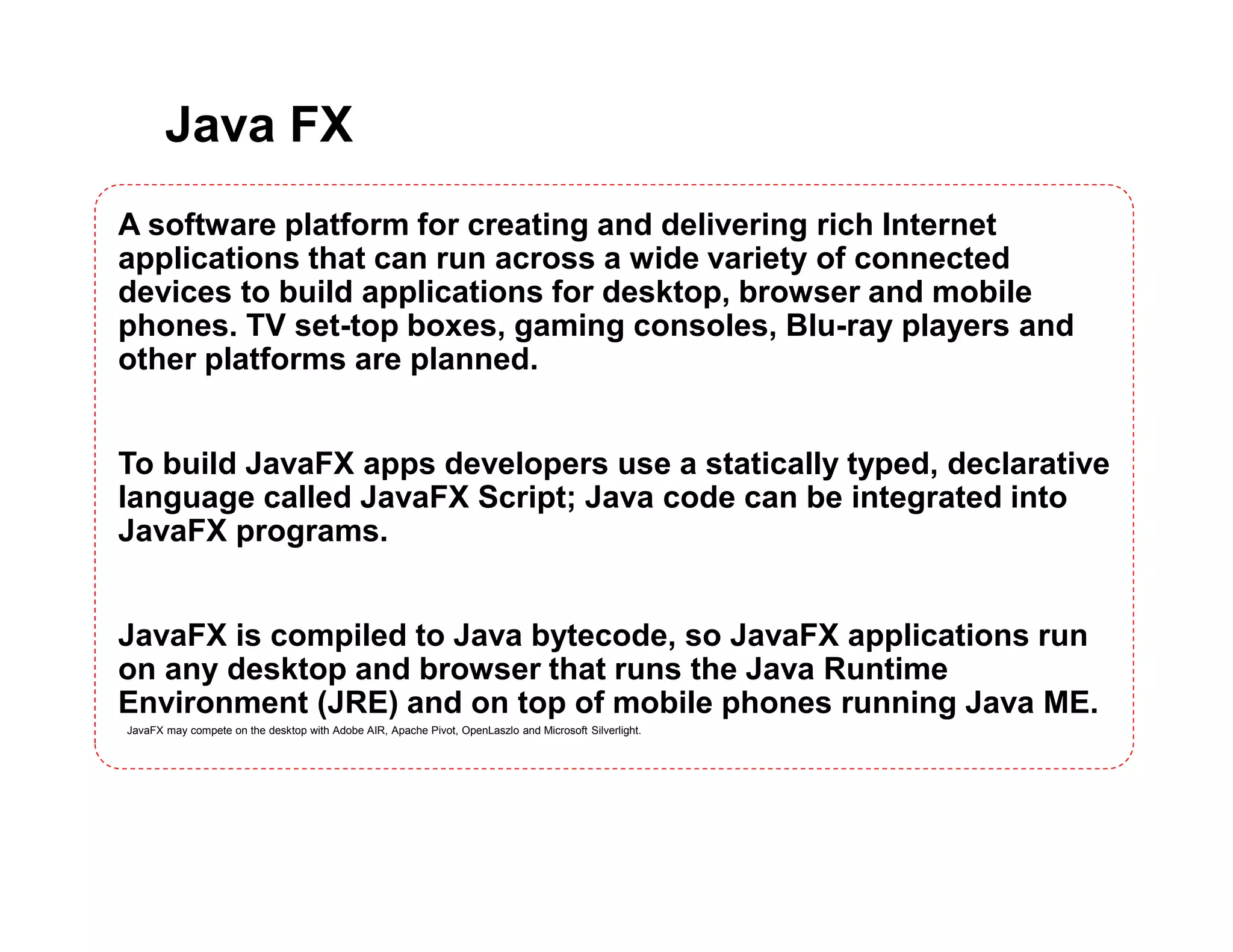

![HotSpot JVM Options Option and Default Value Description -XX:-AllowUserSignalHandlers Do not complain if the application installs signal handlers. (Relevant to Solaris and Linux only.) -XX:AltStackSize=16384 Alternate signal stack size (in Kbytes). (Relevant to Solaris only, removed from 5.0.) -XX:-DisableExplicitGC Disable calls to System.gc(), JVM still performs garbage collection when necessary. -XX:+FailOverToOldVerifier Fail over to old verifier when the new type checker fails. (Introduced in 6.) -XX:+HandlePromotionFailure The youngest generation collection does not require a guarantee of full promotion of all live objects. (Introduced in 1.4.2 update 11) [5.0 and earlier: false.] -XX:+MaxFDLimit Bump the number of file descriptors to max. (Relevant to Solaris only.) -XX:PreBlockSpin=10 Spin count variable for use with -XX:+UseSpinning. Controls the maximum spin iterations allowed before entering operating system thread synchronization code. (Introduced in 1.4.2.) -XX:-RelaxAccessControlCheck Relax the access control checks in the verifier. (Introduced in 6.) -XX:+ScavengeBeforeFullGC Do young generation GC prior to a full GC. (Introduced in 1.4.1.) -XX:+UseAltSigs Use alternate signals instead of SIGUSR1 and SIGUSR2 for VM internal signals. (Introduced in 1.3.1 update 9, 1.4.1. Relevant to Solaris only.) -XX:+UseBoundThreads Bind user level threads to kernel threads. (Relevant to Solaris only.) -XX:-UseConcMarkSweepGC Use concurrent mark-sweep collection for the old generation. (Introduced in 1.4.1) -XX:+UseGCOverheadLimit Use a policy that limits the proportion of the VM's time that is spent in GC before an OutOfMemory error is thrown. (Introduced in 6.) -XX:+UseLWPSynchronization Use LWP-based instead of thread based synchronization. (Introduced in 1.4.0. Relevant to Solaris only.) -XX:-UseParallelGC Use parallel garbage collection for scavenges. (Introduced in 1.4.1) -XX:-UseParallelOldGC Use parallel garbage collection for the full collections. Enabling this option automatically sets -XX:+UseParallelGC. (Introduced in 5.0 update 6.) -XX:-UseSerialGC Use serial garbage collection. (Introduced in 5.0.) -XX:-UseSpinning Enable naive spinning on Java monitor before entering operating system thread synchronizaton code. (Relevant to 1.4.2 and 5.0 only.) [1.4.2, multi-processor Windows platforms: true] -XX:+UseTLAB Use thread-local object allocation (Introduced in 1.4.0, known as UseTLE prior to that.) [1.4.2 and earlier, x86 or with -client: false] -XX:+UseSplitVerifier Use the new type checker with StackMapTable attributes. (Introduced in 5.0.)[5.0: false] -XX:+UseThreadPriorities Use native thread priorities. -XX:+UseVMInterruptibleIO Thread interrupt before or with EINTR for I/O operations results in OS_INTRPT. (Introduced in 6. Relevant to Solaris only.) Behavioral Options Option and Default Value Description -XX:+AggressiveOpts Turn on point performance compiler optimizations that are expected to be default in upcoming releases. (Introduced in 5.0 update 6.) -XX:CompileThreshold=10000 Number of method invocations/branches before compiling [-client: 1,500] -XX:LargePageSizeInBytes=4m Sets the large page size used for the Java heap. (Introduced in 1.4.0 update 1.) [amd64: 2m.] -XX:MaxHeapFreeRatio=70 Maximum percentage of heap free after GC to avoid shrinking. -XX:MaxNewSize=size Maximum size of new generation (in bytes). Since 1.4, MaxNewSize is computed as a function of NewRatio. [1.3.1 Sparc: 32m; 1.3.1 x86: 2.5m.] -XX:MaxPermSize=64m Size of the Permanent Generation. [5.0 and newer: 64 bit VMs are scaled 30% larger; 1.4 amd64: 96m; 1.3.1 -client: 32m.] -XX:MinHeapFreeRatio=40 Minimum percentage of heap free after GC to avoid expansion. -XX:NewRatio=2 Ratio of new/oldgeneration sizes. [Sparc -client: 8; x86 -server: 8; x86 -client: 12.]-client: 4 (1.3) 8 (1.3.1+), x86: 12] -XX:NewSize=2.125m Default size of new generation (in bytes) [5.0 and newer: 64 bit VMs are scaled 30% larger; x86: 1m; x86, 5.0 and older: 640k] -XX:ReservedCodeCacheSize=32m Reserved code cache size (in bytes) - maximum code cache size. [Solaris 64-bit, amd64, and -server x86: 48m; in 1.5.0_06 and earlier, Solaris 64-bit and and64: 1024m.] -XX:SurvivorRatio=8 Ratio of eden/survivor space size [Solaris amd64: 6; Sparc in 1.3.1: 25; other Solaris platforms in 5.0 and earlier: 32] -XX:TargetSurvivorRatio=50 Desired percentage of survivor space used after scavenge. -XX:ThreadStackSize=512 Thread Stack Size (in Kbytes). (0 means use default stack size) [Sparc: 512; Solaris x86: 320 (was 256 prior in 5.0 and earlier); Sparc 64 bit: 1024; Linux amd64: 1024 (was 0 in 5.0 and earlier); all others 0.] -XX:+UseBiasedLocking Enable biased locking. For more details, see this tuning example. (Introduced in 5.0 update 6.) [5.0: false] -XX:+UseFastAccessorMethods Use optimized versionsof Get<Primitive>Field. -XX:-UseISM Use Intimate Shared Memory. [Not accepted for non-Solaris platforms.] For details, see Intimate Shared Memory. -XX:+UseLargePages Use large page memory. (Introduced in 5.0 update 5.) For details, see Java Support for Large Memory Pages. -XX:+UseMPSS Use Multiple Page Size Support w/4mb pages for the heap. Do not use with ISM as this replaces the need for ISM. (Introduced in 1.4.0 update 1, Relevant to Solaris 9 and newer.) [1.4.1 and earlier: false] -XX:+UseStringCache Enables cachingof commonlyallocated strings. -XX:AllocatePrefetchLines=1 Number of cache lines to load after the last object allocationusing prefetch instructions generated in JIT compiled code. Default values are 1 if the last allocated object was an instance and 3 if it was an array. -XX:AllocatePrefetchStyle=1 Generated code style for prefetch instructions. 0 - no prefetch instructions are generate*d*, 1 - execute prefetch instructionsafter each allocation, 2 - use TLAB allocation watermark pointer to gate when prefetch instructions are executed. -XX:+UseCompressedStrings Use a byte[] for Strings which can be represented as pure ASCII. (Introduced in Java 6 Update 21 Performance Release) -XX:+OptimizeStringConcat Optimize String concatenationoperations where possible. (Introduced in Java 6 Update 20) Performance Options Option and Default Value Description -XX:-CITime Prints time spent in JIT Compiler. (Introduced in 1.4.0.) -XX:ErrorFile=./hs_err_pid<pid>.log If an error occurs, save the error data to this file. (Introduced in 6.) -XX:-ExtendedDTraceProbes Enable performance-impacting dtrace probes. (Introduced in 6. Relevant to Solaris only.) -XX:HeapDumpPath=./java_pid<pid>.hprof Path to directory or filename for heap dump. Manageable. (Introduced in 1.4.2 update 12, 5.0 update 7.) -XX:-HeapDumpOnOutOfMemoryError Dump heap to file when java.lang.OutOfMemoryError is thrown. Manageable. (Introduced in 1.4.2 update 12, 5.0 update 7.) -XX:OnError="<cmd args>;<cmd args>" Run user-defined commands on fatal error. (Introduced in 1.4.2 update 9.) -XX:OnOutOfMemoryError="<cmd args>; <cmd args>" Run user-defined commands when an OutOfMemoryError is first thrown. (Introduced in 1.4.2 update 12, 6) -XX:-PrintClassHistogram Print a histogram of class instances on Ctrl-Break. Manageable. (Introduced in 1.4.2.) The jmap -histo command provides equivalent functionality. -XX:-PrintConcurrentLocks Print java.util.concurrent locks in Ctrl-Break thread dump. Manageable. (Introduced in 6.) The jstack -l command provides equivalent functionality. -XX:-PrintCommandLineFlags Print flags that appeared on the command line. (Introduced in 5.0.) -XX:-PrintCompilation Print message when a method is compiled. -XX:-PrintGC Print messages at garbage collection. Manageable. -XX:-PrintGCDetails Print more details at garbage collection. Manageable. (Introduced in 1.4.0.) -XX:-PrintGCTimeStamps Print timestamps at garbage collection. Manageable (Introduced in 1.4.0.) -XX:-PrintTenuringDistribution Print tenuring age information. -XX:-TraceClassLoading Trace loading of classes. -XX:-TraceClassLoadingPreorder Trace all classes loaded in order referenced (not loaded). (Introduced in 1.4.2.) -XX:-TraceClassResolution Trace constant pool resolutions. (Introduced in 1.4.2.) -XX:-TraceClassUnloading Trace unloading of classes. -XX:-TraceLoaderConstraints Trace recording of loader constraints. (Introduced in 6.) -XX:+PerfSaveDataToFile Saves jvmstat binary data on exit. -XX:ParallelGCThreads= Sets the number of garbage collection threads in the young and old parallel garbage collectors. The default value varies with the platform on which the JVM is running. -XX:+UseCompressedOops Enables the use of compressed pointers (object references represented as 32 bit offsets instead of 64-bit pointers) for optimized 64-bit performance with Java heap sizes less than 32gb. -XX:+AlwaysPreTouch Pre-touch the Java heap during JVM initialization. Every page of the heap is thus demand-zeroed during initialization rather than incrementally during application execution. -XX:AllocatePrefetchDistance= Sets the prefetch distance for object allocation. Memory about to be written with the value of new objects is prefetched into cache at this distance (in bytes) beyond the address of the last allocated object. Each Java thread has its own allocationpoint. The default value varies with the platform on which the JVM is running. -XX:InlineSmallCode= Inline a previously compiledmethod only if its generated native code size is less than this. The default value varies with the platform on which the JVM is running. -XX:MaxInlineSize=35 Maximum bytecode size of a method to be inlined. -XX:FreqInlineSize= Maximum bytecode size of a frequently executed method to be inlined. The default value varies with the platform on which the JVM is running. -XX:LoopUnrollLimit= Unroll loop bodies with server compilerintermediate representationnode count less than this value. The limit used by the server compileris a function of this value, not the actual value. The default value varies with the platform on which the JVM is running. -XX:InitialTenuringThreshold=7 Sets the initialtenuring threshold for use in adaptive GC sizing in the parallel young collector. The tenuring threshold is the number of times an object survives a young collection before being promoted to the old, or tenured, generation. -XX:MaxTenuringThreshold= Sets the maximum tenuringthreshold for use in adaptive GC sizing. The current largest value is 15. The default value is 15 for the parallelcollectorand is 4 for CMS. Debugging Options](https://image.slidesharecdn.com/01introtojava-151031160307-lva1-app6891/75/Java-Programming-01-intro-to-java-13-2048.jpg)
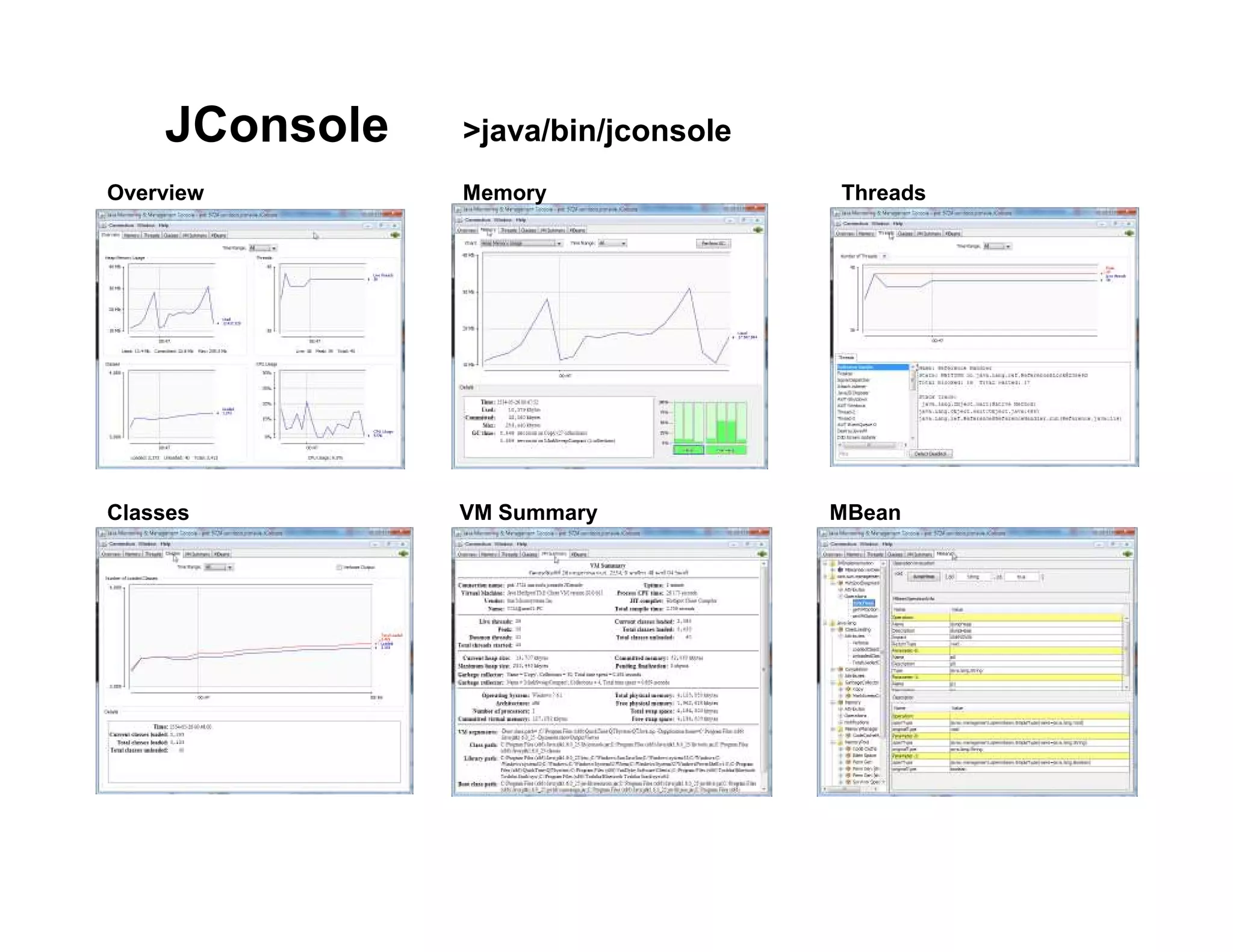
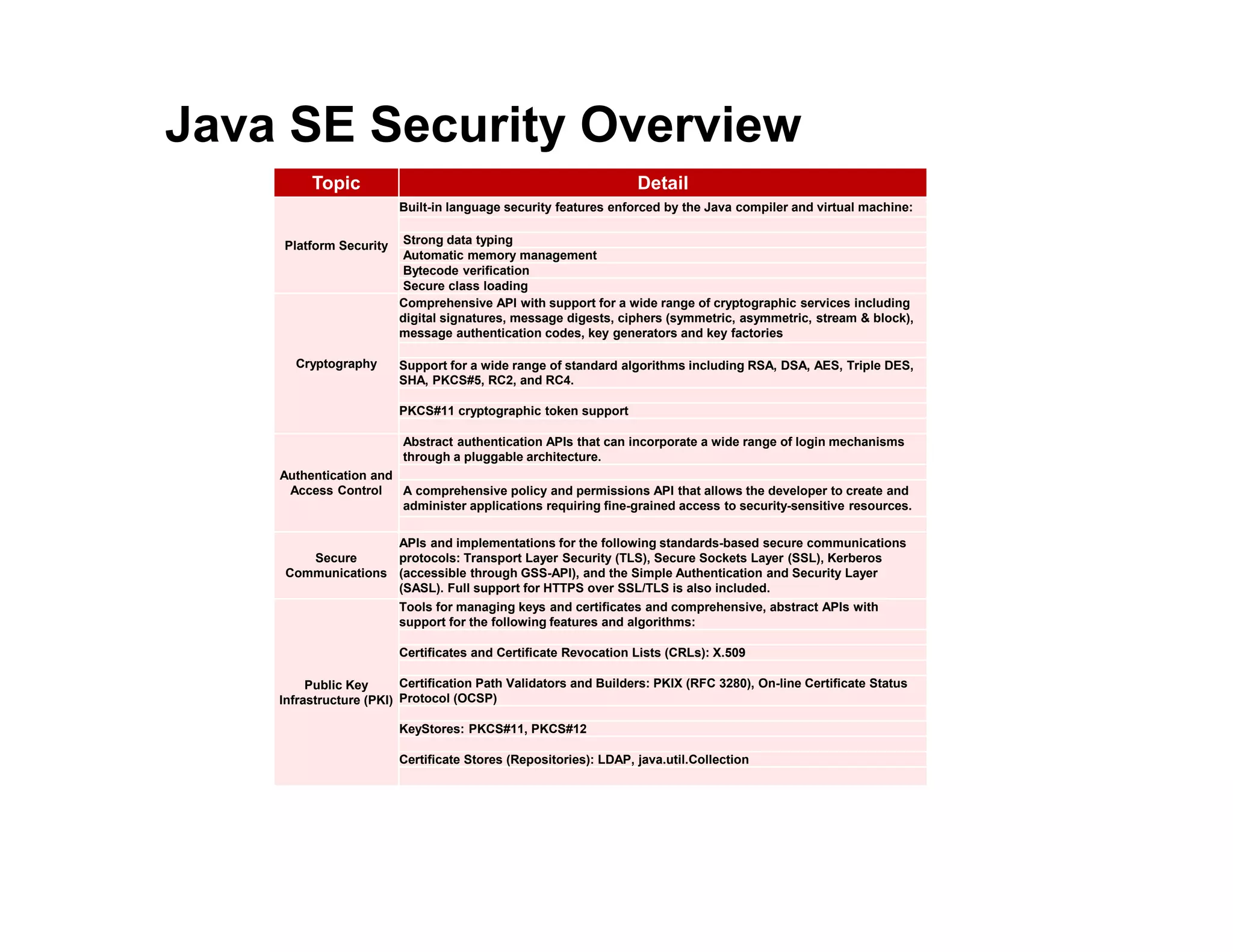
![Writing a First Java Program public class Class1 { public static void main(String[] args) { System.out.println("Hello World"); } } Compile: >javac Class1.java Execute: >java Class1](https://image.slidesharecdn.com/01introtojava-151031160307-lva1-app6891/75/Java-Programming-01-intro-to-java-16-2048.jpg)

